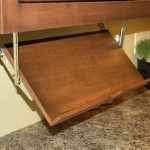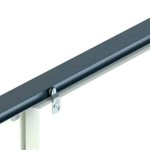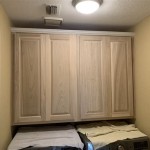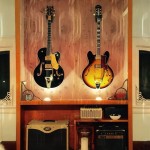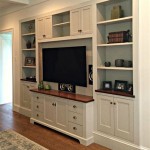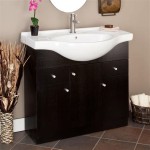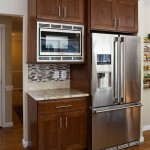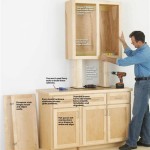How to Make a Built-in Refrigerator Cabinet
A built-in refrigerator cabinet seamlessly integrates your refrigerator into your kitchen design, creating a cohesive and elegant look. This project can be a substantial undertaking, but with careful planning and execution, you can achieve a stunning result. This guide provides a detailed breakdown of the steps involved in building a custom refrigerator cabinet, helping you navigate the process with confidence.
1. Planning and Preparation
Before embarking on this DIY project, thorough planning is essential. Begin by measuring your refrigerator's dimensions, including its depth, height, and width. This information is crucial for determining the size of your cabinet and the materials needed. Consider the surrounding cabinetry and countertop heights to ensure smooth integration. Determine the desired cabinet style, whether it's a simple, modern design or a more elaborate, traditional look. You can find inspiration from online sources, magazines, and kitchen design professionals.
Next, choose the materials for your cabinet. Plywood is a popular choice for its durability and affordability. Consider using a moisture-resistant plywood for cabinetry sections that might be exposed to moisture. For the cabinet doors, you can opt for solid wood, engineered wood, or a combination of both. Ensure the materials you select complement the existing cabinetry in your kitchen.
Finally, gather the necessary tools and equipment. This will include a table saw, circular saw, drill, jigsaw, router, sander, measuring tape, level, and clamps, among others. Your tools should be in good working condition to ensure accurate cuts and a smooth finish.
2. Building the Cabinet Frame
Constructing the cabinet frame is the foundation of your built-in refrigerator cabinet. Begin by cutting the plywood sheets to the desired dimensions for the sides, top, bottom, and back of the cabinet. Remember to account for the thickness of the doors and any trim you plan to incorporate. Once the pieces are cut, use wood glue and screws to secure them together.
For additional strength and rigidity, consider adding a center support frame. This helps distribute weight and prevents sagging, especially if you're building a large cabinet. This frame can be made from plywood or wood strips, depending on your preference. Ensure it's securely attached to the cabinet frame.
3. Designing and Incorporating Doors
The doors of your built-in refrigerator cabinet are crucial for access and aesthetics. You can choose to build doors from scratch or purchase pre-made doors that fit your dimensions. When building doors, consider the style and materials. Standard-sized cabinet doors are available in various styles, including shaker, flat panel, and raised panel, offering options to match your kitchen's aesthetic.
If you are building the doors yourself, you will need to cut the pieces, make any necessary mortises or rabbets for hinges, and assemble the door frames. If you are using pre-made doors, ensure they are sized correctly and align perfectly with the cabinet opening. Remember to factor in the thickness of the doors and the space required for hinges and handles.
The doors should also be installed with concealed hinges for a clean, integrated look. Measure and mark the locations for the hinges carefully before drilling pilot holes. Ensure the hinges are aligned correctly to guarantee smooth door operation.
4. Finishing Touches and Installation
Once the cabinet is constructed, it's time to add the finishing touches. This includes sanding the surfaces, painting, or staining the cabinet to complement your kitchen's color scheme. You can also consider adding decorative trim or molding to enhance the appearance. Remember to apply a sealant or polycrylic coating for protection and durability.
The final step is to install the cabinet. If you are replacing an existing freestanding refrigerator, you will need to remove it and disconnect the power supply. Ensure the cabinet sits level on the floor, and secure it to the surrounding cabinetry or walls for stability. If you are building the cabinet in a new space, you will need to prepare the area by leveling the floor and securing the cabinet to the structure.
Lastly, install the refrigerator by sliding it into the cabinet and connecting the power supply. You may need to adjust the cabinet's height or depth slightly to ensure a snug fit. Once the refrigerator is in place, you can admire your custom built-in refrigerator cabinet, which seamlessly integrates with your kitchen design and enhances the overall aesthetic appeal.

How To Build In Your Refrigerator Young House Love

How To Build A Refrigerator Surround

How To Build A Diy Refrigerator Cabinet Built In Angela Marie Made

How To Build In Your Refrigerator Young House Love

How To Build A Refrigerator Surround Cabinet Make It With Kate

How To Build A Diy Refrigerator Cabinet Built In Angela Marie Made
How To Build A Refrigerator Cabinet Surround Ana White
.jpg?strip=all)
How To Add Panels A Regular Refrigerator

How To Build A Refrigerator Cabinet Surround Ana White
.jpg?strip=all)
How To Add Panels A Regular Refrigerator
Related Posts

